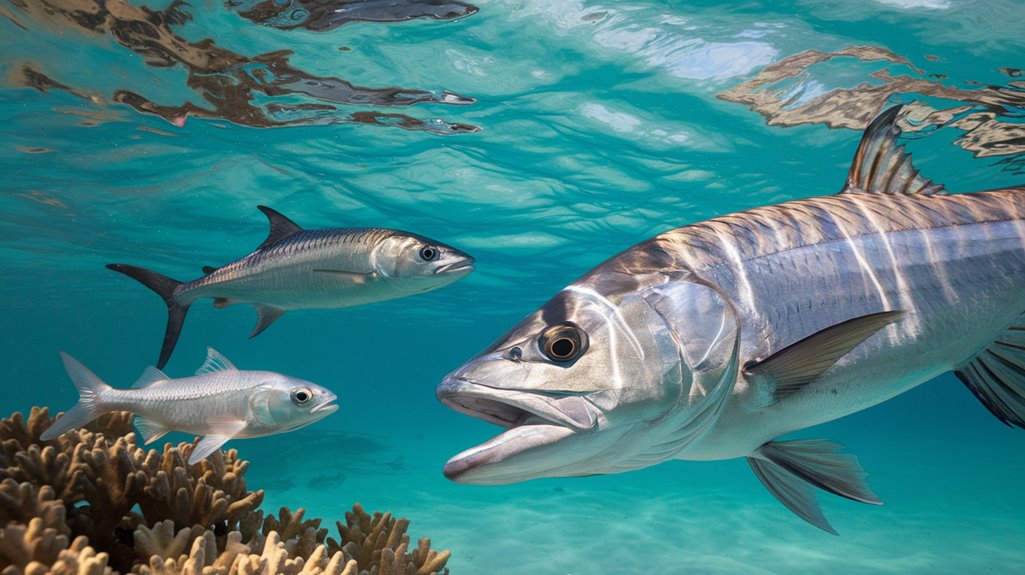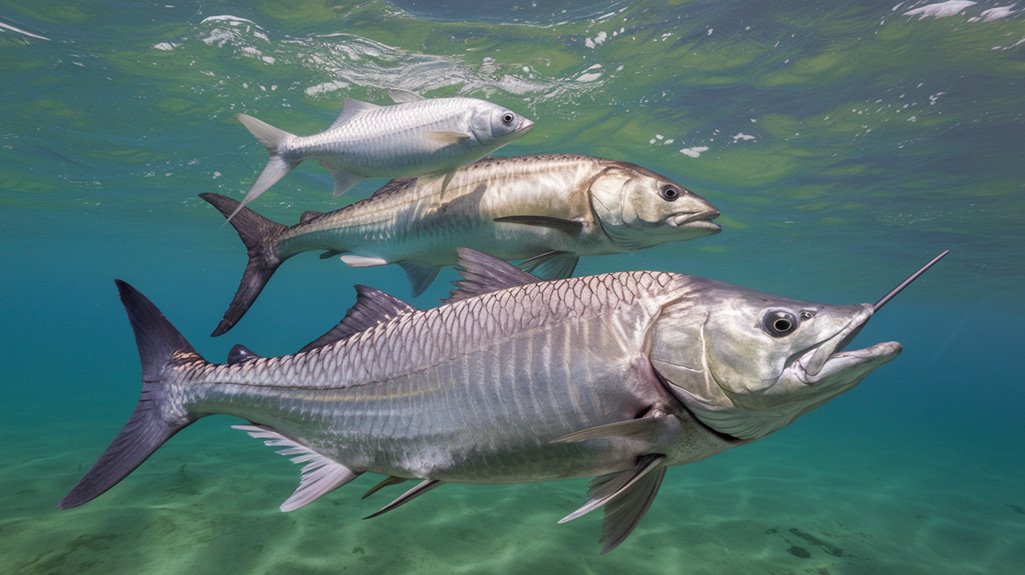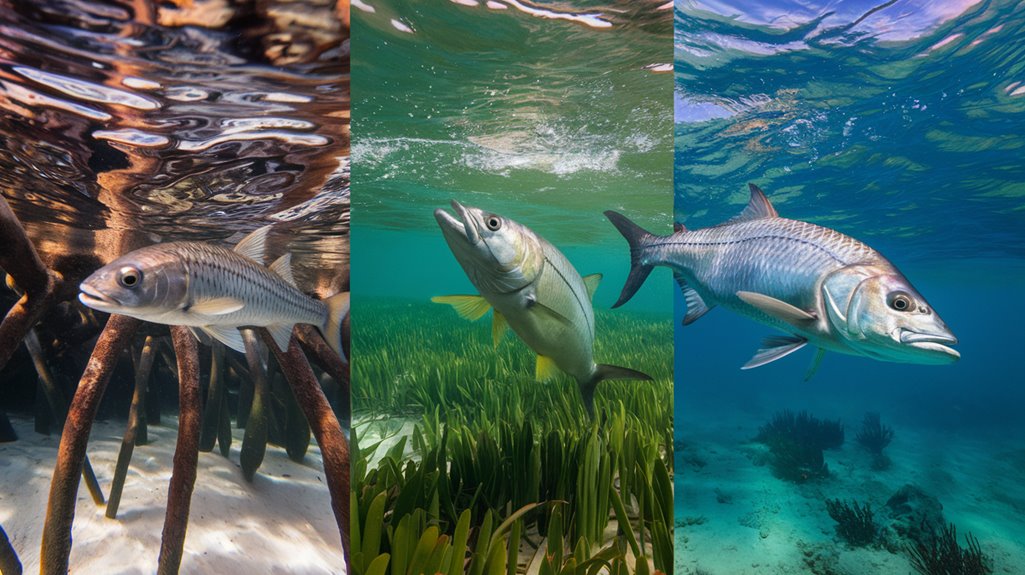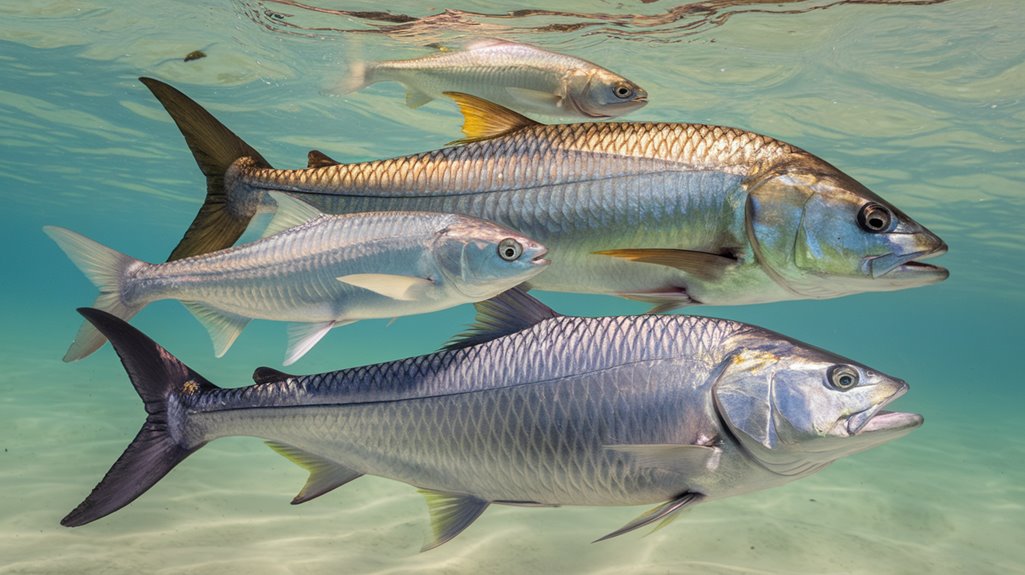You'll find tarpon's growth trajectory fascinating due to its dramatic metamorphosis from juvenile to adult stages. These prehistoric fish begin life as minuscule leptocephalus larvae, yet develop into formidable apex predators through distinct physiological phases. From their initial 3-inch length at hatching to potential adult sizes exceeding 8 feet, tarpon demonstrate one of the most remarkable size progressions among coastal fish species. The mechanisms behind this transformation reveal critical insights into their biology.
- Key Takeaways
- The Remarkable Growth Journey of Tarpon
- Juvenile Size Range and Development
- Physical Transformations During Maturation
- Adult Tarpon Size Classifications
- Environmental Factors Affecting Tarpon Growth
- Record-Breaking Sizes in Different Regions
- Size Variations Between Species
- Age-Related Size Patterns and Longevity
- Frequently Asked Questions
- Conclusion
Key Takeaways
- Tarpon start as tiny leptocephalus larvae at 3-4 inches and grow into juveniles weighing 5-20 pounds.
- Juvenile tarpon experience rapid growth rates of 25-30 centimeters annually under ideal environmental conditions.
- Sub-adult tarpon reach 4-5 feet in length and weigh between 20-60 pounds as they transition to larger prey.
- Adult tarpon achieve lengths of 4-8 feet and weights from 60-280 pounds, with females typically larger than males.
- Sexual maturity occurs at 8-10 years, with males maturing earlier at 8 years and females at 10 years.
The Remarkable Growth Journey of Tarpon

Throughout their remarkable life cycle, tarpon undergo one of the most dramatic size transformations among marine fish species. Beginning as tiny leptocephalus larvae of just 3-4 inches, these fish initiate their journey in coastal waters. You'll find juvenile tarpon exhibiting impressive growth rates of 25-30 cm annually under ideal conditions, particularly in estuarine environments. As they progress to sub-adult stages, they'll reach lengths of 4-5 feet while expanding their dietary preferences. When tarpon spawn reaches maturity, females typically measure 4.5 feet, while males attain approximately 4 feet in length. The most striking aspect of adult tarpon development is their potential to achieve lengths of 4-8 feet and weights ranging from 60-280 pounds, with exceptional specimens documented at 286 pounds.
Juvenile Size Range and Development
The early developmental stages of tarpon reveal fascinating size variations in juvenile specimens. You'll find these young fish initially measuring just 3-4 inches during their leptocephalus larval phase after hatching. As juveniles develop in protected estuarine habitats, they'll reach weights between 5-20 pounds.
The juvenile tarpon's growth rate is remarkably consistent, advancing 25-20 cm annually in both natural and captive environments. Their development depends heavily on habitat quality, with coastal changes and nutrient pollution potentially hindering their progress. You'll observe these fish expanding their diet to include varied prey items like insects, small fish, crabs, and shrimp as they mature. This dietary progression supports their rapid growth within the protective confines of back lagoons, creeks, and mangrove systems.
Physical Transformations During Maturation

During their maturation process, tarpon undergo substantial morphological changes, progressing from juvenile specimens weighing 5-20 pounds to impressive adult specimens reaching 4-8 feet in length and 60-280 pounds in mass. You'll observe distinct physical transformations as they shift from the juvenile stage through sub-adult development to reach sexual maturity. Habitat quality greatly influences their growth trajectory.
| Life Stage | Weight Range | Key Characteristics |
|---|---|---|
| Juvenile | 5-20 lbs | Protected habitat dwelling |
| Sub-adult | 20-60 lbs | Diet diversification |
| Adult | 60-280+ lbs | Sexual maturity (8-10 years) |
The maturation timeline varies by sex, with males reaching sexual maturity around 8 years and females at 10 years. Growth rates during development directly correlate with habitat conditions, showing marked differences between ideal and degraded environments.
Adult Tarpon Size Classifications
You'll find adult tarpon exhibiting remarkable size dimorphism, with females reaching up to 8 feet in length while males typically max out around 4 feet at maturity. Regional variations influence maximum growth potential, as evidenced by differential maturation rates between Florida specimens (10 years) and Costa Rican populations (12 years). The species' impressive longevity of 80+ years enables sustained growth periods, resulting in documented specimens weighing up to 286 pounds, with typical adult weights ranging from 60 to 280 pounds.
Maximum Growth Potential
Reaching extraordinary dimensions in their adult phase, tarpon exhibit remarkable maximum growth potential that places them among the largest coastal gamefish species. You'll find that adult tarpon can attain lengths of 4-8 feet and weights up to 280 pounds, with the record specimen reaching 286 pounds. Their growth trajectory intensifies as they reach maturity, typically at 8-10 years depending on gender.
| Growth Parameter | Ideal Conditions | Sub-optimal Conditions |
|---|---|---|
| Annual Growth Rate | >5 cm/year | 2-5 cm/year |
| Time to Maturity | 8 years (male) | 10 years (female) |
| Maximum Lifespan | 80+ years | 60-70 years |
Their impressive longevity of 80+ years enables sustained growth throughout their life cycle, while juvenile tarpon growth rates remain heavily influenced by habitat quality and environmental conditions.
Size Range By Region
Although tarpon sizes vary across their geographic distribution, distinct regional patterns emerge in adult size classifications. In Florida waters, you'll find tarpon populations reaching maturity at 4-4.5 feet, with females typically larger than males. Caribbean waters host large tarpon in the 100-200 pound range, particularly during their March-July migration through open waters. Costa Rican tarpon demonstrate impressive growth, with specimens regularly reaching 60-150+ pounds during the late summer migration. The Atlantic Ocean, particularly off West Africa's coast, supports some of the largest documented specimens, with exceptional catches up to 286 pounds. While juveniles start small in all regions, adult tarpon consistently achieve substantial sizes, with regional variations primarily influenced by local habitat conditions and food availability.
Environmental Factors Affecting Tarpon Growth

Environmental conditions play a pivotal role in determining tarpon growth rates, with studies revealing significant variations between degraded and healthy habitats. You'll find that juvenile tarpon exhibit accelerated growth in nutrient-rich estuarine environments, where abundant food resources support their development. Key environmental factors, including water temperature, salinity, and dissolved oxygen levels, directly influence their metabolic processes and growth potential.
Habitat degradation from coastal development and pollution has eliminated roughly two-thirds of juvenile tarpon habitats, resulting in stunted growth rates of 2-5 cm annually in compromised environments. For ideal conditions, tarpon require access to diverse prey species, unpolluted water, and adequate shelter. These requirements are increasingly threatened by anthropogenic activities and climate change, highlighting the critical importance of preserving their essential habitats for sustained population growth.
Record-Breaking Sizes in Different Regions
You'll find the heaviest recorded tarpon specimen at 286 pounds off West Africa's coast, setting the benchmark for maximum growth potential in the species. In Florida's Gulf waters, mature females reach impressive sizes averaging 4.5 feet, while Caribbean regions like Belize and Costa Rica consistently produce trophy-class specimens ranging from 70 to 150+ pounds. The Atlantic coastal waters support remarkable tarpon populations, with migratory fish frequently exceeding 200 pounds during peak seasons, demonstrating the species' ability to achieve substantial mass across various geographic regions.
Gulf Region Giants
When anglers seek record-breaking tarpon in the Gulf region, they'll encounter some of the world's most impressive specimens, with documented catches reaching up to 286 pounds off West Africa's coast. The Gulf of Mexico offers prime fishing opportunities for migratory tarpon, particularly during the peak season from April to September.
| Location | Size Range (lbs) | Peak Season | Habitat Type |
|---|---|---|---|
| Gulf Coast | 70-150 | Apr-Sep | Coastal Waters |
| Back Lagoons | 5-20 | Year-round | Protected Waters |
| Costa Rica Reserve | 60-150+ | Year-round | Jungle Waters |
| Mexico Waters | 100-200 | May-Aug | Deep Channels |
You'll find these giants have been caught consistently in less pressured areas, with mature specimens typically measuring 4-8 feet in length. The Gulf's diverse ecosystem supports both juvenile development in protected waters and adult migration patterns in open waters.
Atlantic Coast Records
The Atlantic Coast's record-breaking tarpon catches have set impressive benchmarks for anglers worldwide. The current Atlantic Coast record stands at 286 pounds, demonstrating why these fish are such sought-after game fish. Along these waters, mature tarpon can reach lengths exceeding 8 feet, with female specimens typically achieving larger sizes than males.
You'll find that record catches vary considerably by region, with Florida's waters producing some of the most substantial specimens. Female tarpon in this area commonly reach 4.5 feet and weights up to 280 pounds, while males typically measure around 4 feet. In contrast, juvenile tarpon in protected coastal waters weigh between 5 to 20 pounds. These size variations reflect the species' remarkable growth potential, particularly in the productive waters between Florida and the Caribbean.
Caribbean Trophy Catches
Throughout the Caribbean region, trophy tarpon catches demonstrate remarkable size variations, with numerous specimens exceeding 200 pounds in prime fishing locations. The current record stands at 286 pounds, exemplifying the species' extraordinary growth potential. When tarpon migrate through the Florida Keys and Bahamas, you'll find these sought after gamefish congregating in significant numbers from March to July.
Boca Grande Pass has emerged as a premier destination where schools of tarpon gather, offering anglers opportunities to land trophy tarpon during peak seasons. While regional variations exist, Costa Rica's waters consistently produce specimens ranging from 60 to 150 pounds. These size differentials across Caribbean waters provide invaluable data for understanding growth patterns and population dynamics of this iconic species in distinct marine ecosystems.
Size Variations Between Species
Both major tarpon species demonstrate remarkable similarities in their maximum size potential, with the Atlantic tarpon (M. atlanticus) and Indo-Pacific tarpon (M. cyprinoides) reaching impressive lengths of 4-8 feet and weights between 60-280 pounds.
The size variations between juvenile and adult tarpon are substantial, with notable distinctions in habitat preferences:
- Juvenile tarpon occupy estuarine environments, weighing 5-20 pounds
- Adult specimens can exceed 200 pounds, with record catches of 286 pounds
- Sexual dimorphism exists, with females maturing at 4.5 feet and males at 4 feet
You'll find these size variations consistent across both species, though individual growth rates may differ based on environmental conditions. The progression from larval stage to full maturity represents a remarkable transformation in both Atlantic and Indo-Pacific populations.
Age-Related Size Patterns and Longevity
As tarpon progress through distinct life stages, their size patterns follow predictable trajectories aligned with age-specific habitat preferences and dietary shifts. You'll find juvenile tarpon weighing 5-20 pounds in protective environments, while sub-adults shift to larger prey and expand their range. Adult tarpon demonstrate remarkable growth potential, reaching weights up to 280 pounds and lengths of 8 feet.
| Life Stage | Weight Range (lbs) | Key Characteristics |
|---|---|---|
| Juvenile | 5-20 | Back lagoons, rapid growth |
| Sub-adult | 20-80 | Expanded diet, changeover |
| Adult | 60-280 | Peak size, late maturation |
The species' exceptional longevity of 80+ years contributes to their vulnerability, as their slow growth and delayed maturation make populations susceptible to environmental pressures and fishing impacts. Female tarpon mature later than males, reaching reproductive age around 10 years.
Frequently Asked Questions
How Old Is a 100 Pound Tarpon?
You'll find that a 100-pound tarpon is typically 7-8 years old, though this can vary based on environmental conditions, growth rates, and the specimen's sex, particularly in females.
How Big Are Tarpon Fish?
You'll find tarpon's size varies greatly across life stages: juveniles measure 2-3 feet and 5-20 pounds, sub-adults reach 4-6 feet and 20-80 pounds, while adults grow 4-8 feet and 60-280 pounds.
Where Is the Best Place to Catch Juvenile Tarpon?
You'll find prime juvenile tarpon habitats in back lagoons, mangroves, and creeks. Specific locations like Campeche Tarpon Lodge, Isla del Sabalo, and Fly Fishing Tabasco consistently yield 5-20 pound specimens.
What Is the Largest Tarpon Ever Caught?
You'll find that the largest tarpon ever caught weighed 286 pounds, captured off West Africa's coast. This specimen exceeded standard adult tarpon dimensions, measuring over 8 feet in length.
Conclusion
You'll observe that tarpon (Megalops atlanticus) exhibit remarkable ontogenetic development, progressing from 3-4 inch juveniles to potentially 8-foot adults through distinct morphological stages. Your analysis of their growth metrics indicates significant biomass increases from 5-20 pounds to 60-280 pounds at maturity. When you're evaluating their development, you'll need to take into account both phenotypic plasticity and environmental parameters as key determinants of their maximum size potential.

